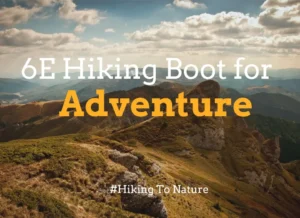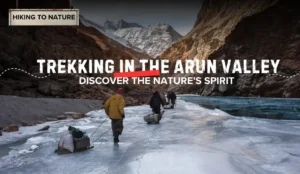Any outdoor lover’s ideal hike would be the Pacific Crest Trail, which takes you through some of the most breathtaking landscapes in North America and is a dream for any nature enthusiast.
The journey begins in the southern California deserts and ends in the verdant forests of Washington State, covering more than 2,650 miles.
This blog will cover all the essentials of hiking the Pacific Crest Trail. All the information you need, from when to set out on your adventure to what gear is must-have, how to navigate the varied ecosystems, and how to mentally and physically prepare for this epic expedition.
Preparation for Pacific Crest Trail Hiking

Every day, you’ll burn hundreds of calories while hiking.
To complete the Pacific Crest Trail (PCT), one must be physically fit because of the high endurance required. To increase your endurance, take long hikes while carrying a heavy burden.
Strength training is a must to improve your balance on uneven ground. This will help you build strong core muscles.
Patience and energy are required, and nature is an excellent energy source.
For better equilibrium, work on your abs, legs, and back. Regularly do aerobic exercises like jogging or cycling to improve your fitness level.
You should be physically fit but not strive for “perfect” fitness. You can increase your stamina and strength just by walking the trail.
Make sure you’re well-prepared for the hike and know that the obstacles you face will change as you go.
Distance and Difficulty: Is This Trail Right for You?

Across varied and rugged landscapes, the 2,650-mile Pacific Crest Trail (PCT) extends from Mexico to Canada. Due to its length and numerous height variations, it is considered one of the world’s most challenging long-distance treks.
A substantial time commitment is required to complete the full path, which usually takes four to six months.
You will encounter challenging landscapes, high elevations, and severe weather along the way.
One must look at one’s preparedness for the challenge before committing to the PCT, although the experience can be rewarding if one is physically and emotionally ready.
Are there any permits or fees required?

Yes, hiking the Pacific Crest Trail (PCT) requires specific permits:
PCT Long-Distance Permit is necessary for those hiking more than 500 continuous miles. Apply early, as permits are limited.
Wilderness Permits Some trail sections, especially in high-traffic areas like the Sierra Nevada, require additional permits. These regulate access to fragile environments.
Campfire Permits Required for using a stove, lantern, or campfire in certain areas
Most permits are free, but certain regions may have associated fees, especially for wilderness permits.
Are there camping options along the trail?
There are numerous camping options along the Pacific Crest Trail (PCT), ranging from designated campsites to dispersed camping in wilderness areas.
No camping zones or fire bans are just two examples of the kinds of specific limitations that you should always research before camping.
Is the trail dog-friendly?

The Crest Trail is dog-friendly (except in national parks). However, it would help if you considered the rugged terrain and the possibility of no water sources.
Bring more water, and be sure your dog can handle steep, rough paths. Always pick up after your dog and make sure they are leashed when needed.
What wildlife might I encounter on the trail?
Deer, elk, and even coyotes are among the animals you can see when hiking the Crest Trail.

Common smaller animals include chipmunks, rabbits, and squirrels. Particularly during the warmer months, keep an eye out for snakes, especially rattlesnakes.
Essential Items to Pack for Pacific Crest Trail Hiking
Bring the following items to guarantee a pleasant and safe trip along the Pacific Crest Trail:
Navigation Tools: A compass, map, GPS, and a trail book or app
Shelter: Bring a lightweight tent, bivy bag, or rainfly-equipped hammock
Clothing: Layers designed for different climates, base layers that drain away moisture, rain gear, thermal insulation, a cap, gloves, and additional socks.
Food and Water: A dependable water filter, cleaner, or chemical treatment; a pot, a stove, fuel, and non-perishable, high-calorie food.
First Aid Kit: Blister care, bandages, antiseptic, pain relievers, personal medications, and an emergency whistle.
Sun Protection: a wide-brimmed hat and sunscreen (SPF 30+) to shield your skin from the sun’s rays.
Multi-tool: For gear repairs, knives, scissors, and tweezers.
Headlamp: With extra batteries and possibly a backup light source.
Fire Starter: Waterproof matches, lighter, firestarter, and emergency fire kit.
Bear Canister: Required in some areas for safe food storage.
Backpack: Comfortable, adequately fitted with a rain cover.
Trekking Poles: These are for stability and reducing the impact on joints.
Sleeping Gear: A sleeping pad and a lightweight sleeping bag rated for the season.
Communication Device: Satellite phone or personal locator beacon (PLB) for emergencies.
Insect Repellent: Especially in mosquito-prone areas.
Waste Management: Trowel for digging cat holes and bags for packing waste in areas where required.
Prepare yourself for the varied circumstances of the Pacific Crest Trail with these essentials, which address safety, comfort, and survival.
Is the trail well-marked and maintained?
While most of the Pacific Crest Trail is well-marked and well-maintained, there are sections where the conditions could be more consistent.
While most of the trail is well-marked and has apparent signs, less-populated portions may have fewer markers, thicker vegetation, or even fallen trees that block the path.
Sections covered in snow, especially at the beginning of the season, might make it difficult to see the trail. Bring a map, GPS, or dependable trail app, and be ready for different trail conditions while you hike.
How to Stay Safe on the Pacific Crest Trail?

To stay safe on the Pacific Crest Trail, follow these essential tips:
Plan Ahead: Research trail conditions, weather, and water sources. Share a detailed itinerary with someone who can check your progress.
Navigation: Carry a map, compass, and GPS device or trail app. Be familiar with how to use them, especially in areas where the trail may be less marked or covered in snow.
Stay Hydrated: Identify water sources in advance and carry a reliable water filter or purifier. Always have extra water, especially in dry sections.
Weather Preparedness: Be ready for changing weather conditions, especially in high elevations. Pack appropriate clothing layers and rain gear.
Wildlife Awareness: Store food properly, use bear canisters where required, and avoid leaving food scraps. Know how to react if you encounter wildlife, particularly bears or mountain lions.
Foot Care: Prevent blisters and injuries by wearing well-fitted, broken-in hiking boots and changing socks regularly. Carry blister treatment in your first aid kit.
Health and First Aid: Carry a comprehensive kit and know basic first aid, including how to treat blisters, cuts, and hypothermia.
Trail Etiquette:
- Follow Leave No Trace principles—pack out all waste.
- Stay on the trail.
- Respect other hikers.
Know Your Limits: Hike at a pace that suits your fitness level. Be mindful of signs of exhaustion, dehydration, or altitude sickness, and take breaks when needed.
Emergency Preparedness: Carry a personal locator beacon (PLB) or satellite phone for emergencies, especially in remote areas without cell service.
Following these safety guidelines can minimize risks and ensure a safer, more enjoyable experience on the Pacific Crest Trail.
What Makes Pacific Crest Trail Special?

A unique aspect of the 2,650-mile Pacific Crest Trail (PCT) is the variety of landscapes it passes through.
These include the verdant forests of Washington, the scorching deserts of Southern California, the towering peaks of the Sierra Nevada, and the volcanic terrains of Oregon.
It passes through seven national parks and twenty-five national forests, with Forester Pass as its highest point at 13,153 feet.
The trail’s notoriously tricky elevation changes, and isolated parts provide a severe test of physical stamina.
Attracting hikers from all over the globe, the PCT’s cultural importance and breathtaking natural scenery are highlighted by its classification as a National Scenic Trail.
What is the best time of year to hike this trail?
The best time to hike the Pacific Crest Trail (PCT) depends on the section you’re tackling:
Southern California (Campo to Kennedy Meadows): Ideal from mid-March to late May when temperatures are more relaxed and water sources are more reliable. Avoid the intense summer heat.
Sierra Nevada (Kennedy Meadows to Northern Yosemite): Best from mid-June to early July, after snowmelt but before the risk of early snowfall. Snow can linger in the high elevations until June.
Northern California (Yosemite to Oregon Border): Late June to early September is optimal, with warm temperatures and primarily snow-free trails.
Oregon: July through September offers the best conditions, with snow-free trails and mild weather. Wildflowers peak in July.
Washington: Late July to mid-September is ideal, as snow melts late in higher elevations. Fall colors appear in September, but the weather becomes more unpredictable.
For thru-hikers, starting in late April to early May in Southern California and finishing in Washington by late September is expected to avoid extreme weather conditions.
How long does it take to complete the hike?
Completing the Pacific Crest Trail (PCT) typically takes 4 to 6 months for a thru-hike. The time varies based on individual pace, trail conditions, weather, and time taken for rest days or side trips.
Fast Hikers: Some experienced hikers can complete the trail in as little as 3.5 to 4 months, averaging 20-30 miles daily.
Average Pace: Most hikers take about five months, averaging 15-20 miles daily.
Slower Pace: Those taking a more leisurely approach or encountering challenging conditions might take up to 6 months, averaging 10-15 miles daily.
What are some must-see highlights along the trail?

Mount Whitney (CA): Highest peak in the contiguous U.S.
John Muir Trail (CA): Iconic stretch through Yosemite and the High Sierra.
Crater Lake (OR): The deepest lake in the U.S. with stunning views.
Cascade Locks Trailhead (OR): Gateway to the Pacific Crest Trail with sweeping views of the Columbia River Gorge.
Sierra Nevada (CA): Rugged mountains and alpine lakes.
Three Sisters Wilderness (OR): Volcanic peaks and lush meadows.
Goat Rocks Wilderness (WA): Dramatic ridgelines and views of Mount Rainier.
Kendall Katwalk (WA): Narrow, thrilling trail carved into a steep mountainside with panoramic views of the Alpine Lakes Wilderness.
Mount Rainier NP (WA): Glaciers and scenic valleys.
Bridge of the Gods (OR/WA): Historic crossing at the Columbia River.
North Cascades (WA): Remote, rugged wilderness and jagged peaks.
As a Hiker, Your Responsibly

Follow Leave No Trace by staying on trails, packing out trash, properly disposing of waste, minimizing campfire impact, respecting wildlife, and being considerate of other hikers.
These actions protect the environment and preserve the trail for all.
Recommended Maps
Halfmile’s PCT Maps: These are free, detailed maps that PCT hikers highly regard.
National Geographic PCT Topographic Map Guide: Covers the entire trail with detailed topographic maps
Recommended Guidebooks
PCT Data Book: A concise guide with essential mile-by-mile data.
Pacific Crest Trail: Northern, Central, and Southern California by Wilderness Press: A comprehensive set of guidebooks covering the trail in three sections.
Yogi’s PCT Handbook: Offers practical advice, town guides, and resupply information from experienced hikers.
Guthook’s PCT App: A GPS-enabled smartphone app with maps, elevation profiles, and waypoint information.
Discover Local Hiking Groups for Support and Guided Adventures
Meetup: Search hiking groups on Meetup.com.
Sierra Club: Join local chapter hikes via Sierra Club.
AllTrails: Connect with hikers on the AllTrails app.
These resources will help you find and join local hiking groups.
Let’s Start The Pacific Crest Trail Hike
Come on, why not go for a hike? Find joy in trekking while embracing the beauty of nature.
Embark on a journey into the wilderness and discover the beauty and serenity that awaits you.






